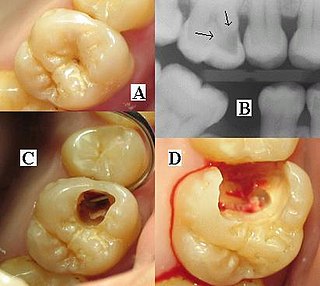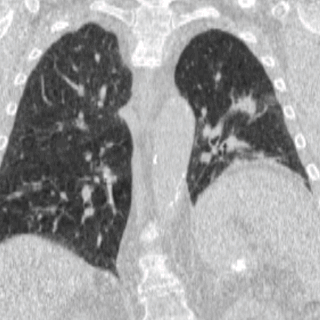Imaging for treatment guidance
Fluoroscopy
Fluoroscopy is an imaging technique that uses a fluoroscope, in coordination with either a screen or image-capturing device to create real-time images of patients' internal structures.
Digital X-ray
Digital X-ray equipment mounted in the radiation treatment device is often used to picture the patient’s internal anatomy at time before or during treatment, which then can be compared to the original planning CT series. Usage of an orthogonal set-up of two radiographic axes is common, to provide means for highly accurate patient position verification. [5]
Computed tomography (CT)
A medical imaging method employing tomography where digital geometry processing is used to generate a three-dimensional image of the internal structures of an object from a large series of two-dimensional X-ray images taken around a single axis of rotation. CT produces a volume of data, which can be manipulated, through a process known as windowing, in order to demonstrate various structures based on their ability to attenuate and prevent transmission of the incident X-ray beam.
Conventional CT
With the growing recognition of the utility of CT imaging in using guidance strategies to match treatment volume position and treatment field placement, several systems have been designed that place an actual conventional 2-D CT machine in the treatment room alongside the treatment linear accelerator. The advantage is that the conventional CT provides accurate measure of tissue attenuation, which is important for dose calculation (e.g. CT on rails). [8]
Cone beam
Cone-beam computed tomography (CBCT) based image guided systems have been integrated with medical linear accelerators to great success. With improvements in flat-panel technology, CBCT has been able to provide volumetric imaging, and allows for radiographic or fluoroscopic monitoring throughout the treatment process. Cone beam CT acquires many projections over the entire volume of interest in each projection. Using reconstruction strategies pioneered by Feldkamp, the 2D projections are reconstructed into a 3D volume analogous to the CT planning dataset.
MVCT
Megavoltage computed tomography (MVCT) is a medical imaging technique that uses the Megavoltage range of X-rays to create an image of bony structures or surrogate structures within the body. The original rational for MVCT was spurred by the need for accurate density estimates for treatment planning. Both patient and target structure localization were secondary uses. A test unit using a single linear detector, consisting of 75 cadmium tungstate crystals, was mounted on the linear accelerator gantry.[ citation needed ] The test results indicated a spatial resolution of .5mm, and a contrast resolution of 5% using this method. While another approach could involve integrating the system directly into the MLA[ clarification needed ], it would limit the number of revolutions to a number prohibitive to regular use.[ citation needed ]
Optical tracking
Optical tracking entails the use of a camera to relay positional information of objects within its inherent coordinate system by means of a subset of the electromagnetic spectrum of wavelengths spanning ultra-violet, visible, and infrared light. Optical navigation has been in use for the last 10 years within image-guided surgery (neurosurgery, ENT, and orthopaedic) and has increased in prevalence within radiotherapy to provide real-time feedback through visual cues on graphical user interfaces (GUIs). For the latter, a method of calibration is used to align the camera's native coordinate system with that of the isocentric reference frame of the radiation treatment delivery room. Optically tracked tools are then used to identify the positions of patient reference set-up points and these are compared to their location within the planning CT coordinate system. A computation based on least-squares methodology is performed using these two sets of coordinates to determine a treatment couch translation that will result in the alignment of the patient's planned isocenter with that of the treatment room. These tools can also be used for intra-fraction monitoring of patient position by placing an optically tracked tool on a region of interest to either initiate radiation delivery (i.e. gating regimes) or action (i.e. repositioning). Alternatively, products such as AlignRT (from Vision RT) allow for real time feedback by imaging the patient directly and tracking the skin surface of the patient.
MRI
The first clinically active MRI-guided radiation therapy machine, the ViewRay device, was installed in St. Louis, MO, at the Alvin J. Siteman Cancer Center at Barnes-Jewish Hospital and Washington University School of Medicine. Treatment of the first patients was announced in February 2014. [13] Other radiation therapy machines which incorporate real-time MRI tracking of tumors are currently in development. MRI-guided radiation therapy enables clinicians to see a patient's internal anatomy in real-time using continual soft-tissue imaging and allows them to keep the radiation beams on target when the tumour moves during treatment. [14]
Ultrasound
Ultrasound is used for daily patient setup. It is useful for soft tissue such as the breast and prostate. The BAT (Best Nomos) and Clarity (Elekta) systems are the two main systems currently being used. The Clarity system has been further developed to enable intra-fraction prostate motion tracking via trans-perineal imaging.
Electromagnetic transponders
While not IGRT per se, electromagnetic transponder systems seek to serve exactly the same clinical function as CBCT or kV X-ray, yet provide for more temporally continuous analysis of setup error analogous to that of the optical tracking strategies. Hence, this technology (although entailing the use of no "images") is usually classified as an IGRT approach.










